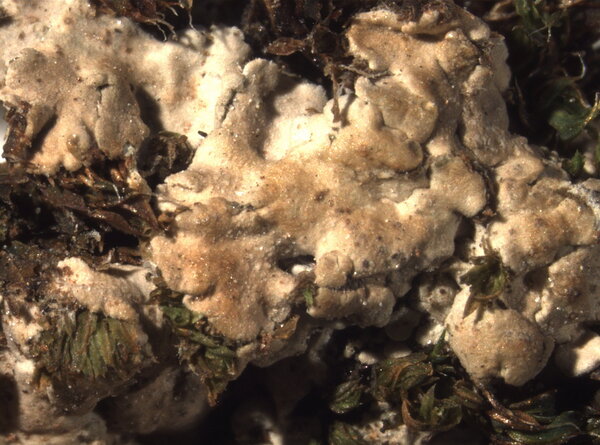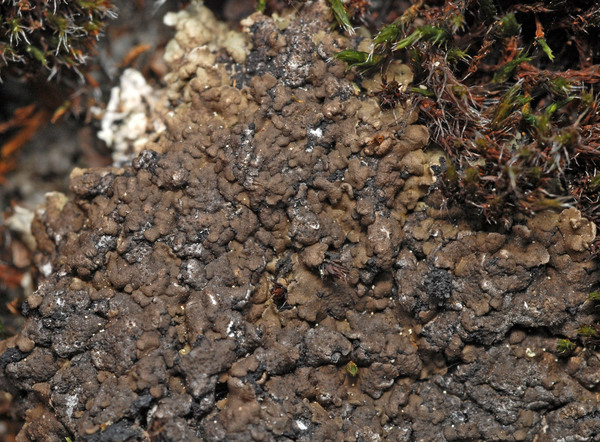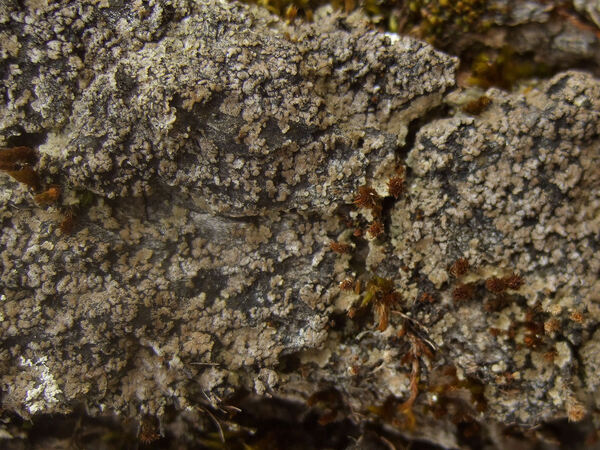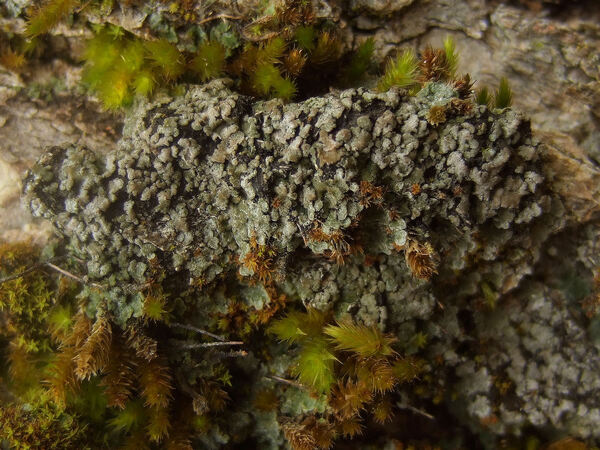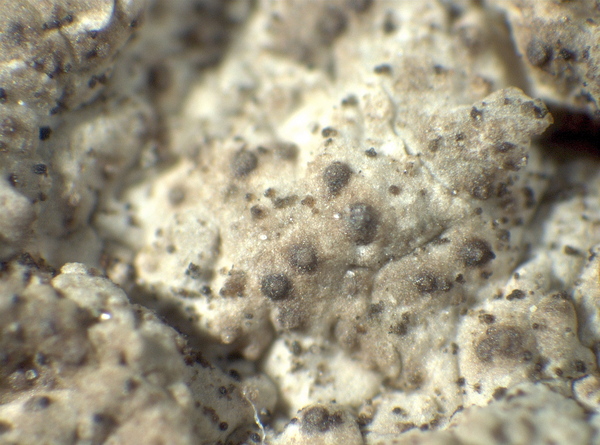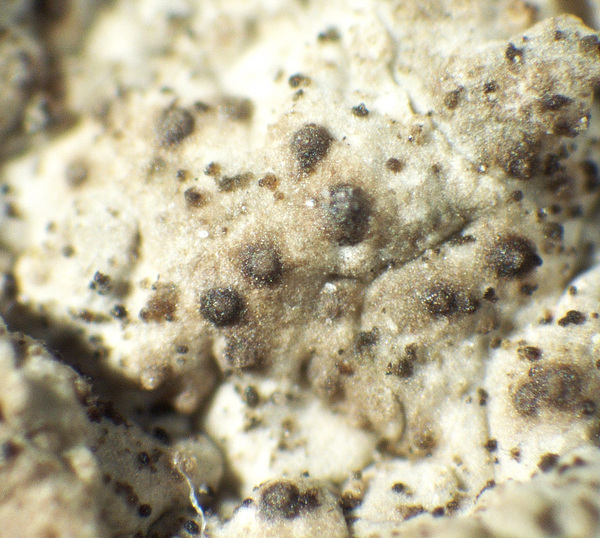Catapyrenium psoromoides (Borrer) R. Sant.
in Hawksworth & al., Lichenologist, 12: 106, 1980. Basionym: Verrucaria psoromoides Borrer in Hooker & Sowerby - Engl. Bot. Suppl. 1, tab. 2612, fig. 1, 1831.
Synonyms: Dermatocarpon daedaleum f. pruinosum Vain.; Dermatocarpon daedaleum var. corticola H. Magn.; Dermatocarpon psoromoides (Borrer) Dalla Torre & Sarnth.; Placocarpus psoromoides (Borrer) Trevis.; Verrucaria psoromia Nyl.
Description: Thallus squamulose, grey to greenish brown, sometimes spottily grey- to violet-pruinose in the distal parts of squamules. Squamules 1-3(-4) mm wide, 0.14-0.33 mm thick, dispersed or more frequently contiguous to slightly imbricate, rather loosely attached, entire or divided, the lower surface with a blackish-brown rhizohyphal web. Upper cortex thin, paraplectenchymatous, of (4-)19(-10) μm wide cells, with an up to 15 μm thick epinecral layer; algal layer poorly delimited from upper cortex; medulla of loose hyphae with many spherical cells and distinct interhyphal spaces; lower cortex absent, the medulla gradually merging into a dark mat of rhizohyphae, the latter 3-4 μm thick, brown to black. Perithecia to 0.2 mm across, pyriform, without involucrellum. Exciple of tangentially arranged, elongated cells, hyaline or pale yellowish-brown, except near the dark ostiole; periphyses rather short (to 30 μm long), often with somewhat swollen apical cells, paraphyses absent; hymenial gel hemiamyloid. Asci 8-spored, unitunicate, clavate, thin-walled, not or only slightly thickened at apex, without ocular chamber, the wall I-, 55-65 x 13-15 µm. Ascospores 1-celled, ellipsoid to subfusiform, 12-19 x 5-7.5 μm, biseriately arranged in the asci. Photobiont chlorococcoid. Spot tests: cortex and medulla K-, C-, KC-, P-, UV-. Chemistry: without lichen substances.
Growth form: Squamulose
Substrata: bark
Photobiont: green algae other than Trentepohlia
Reproductive strategy: mainly sexual
Commonnes-rarity: (info)
Alpine belt: absent
Subalpine belt: absent
Montane belt: extremely rare
Dry submediterranean belt: very rare
Humid submediterranean belt: very rare
Padanian area: absent
pH of the substrata:
1 2 3 4 5
Solar irradiation:
1 2 3 4 5
Aridity:
1 2 3 4 5
Eutrophication:
1 2 3 4 5
Poleotolerance:
0 1 2 3
Altitudinal distribution:
1 2 3 4 5 6
Rarity
absent
extremely rare
very rare
rare
rather rare
rather common
common
very common
extremely common
Loading data...
Occurrence data
Predictive map
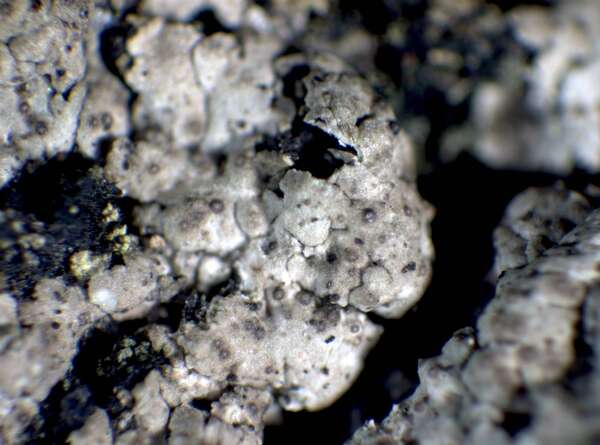
P.L. Nimis; Owner: Department of Life Sciences, University of Trieste
Herbarium: TSB (17935)
2001/11/22
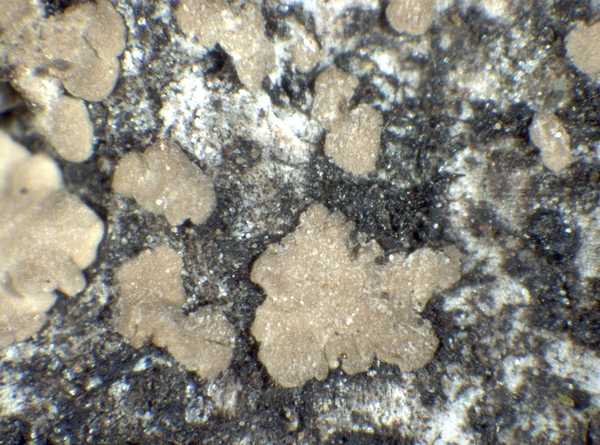
P.L.Nimis; Owner: Department of Life Sciences, University of Trieste
Herbarium: TSB (20351)
2008.03.06
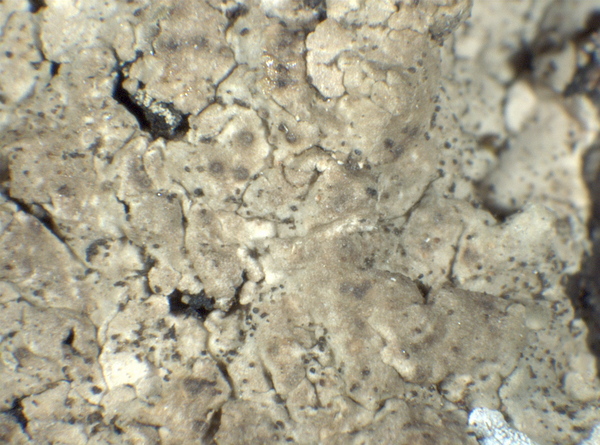
P.L.Nimis; Owner: Department of Life Sciences, University of Trieste
Herbarium: TSB (15305)
2008.03.06
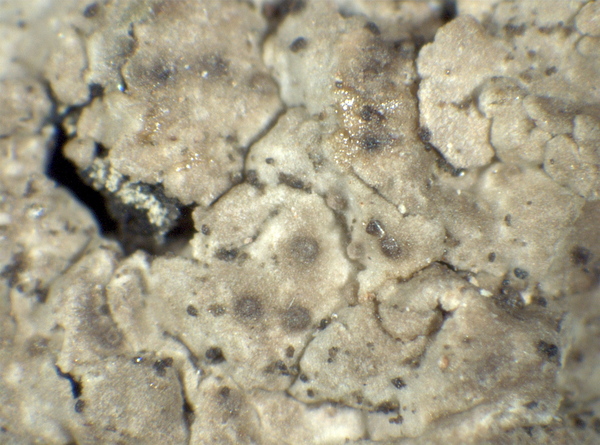
P.L.Nimis; Owner: Department of Life Sciences, University of Trieste
Herbarium: TSB (15305)
2008.03.06
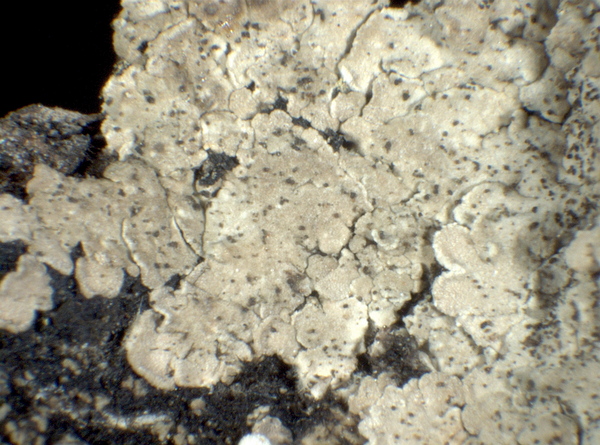
P.L.Nimis; Owner: Department of Life Sciences, University of Trieste
Herbarium: TSB (15305)
2008.03.06
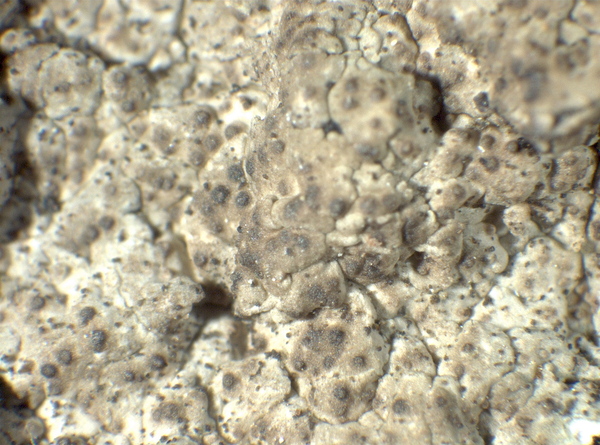
P.L.Nimis; Owner: Department of Life Sciences, University of Trieste
Herbarium: TSB (15305)
2008.03.06
Growth form: Squamulose
Substrata: bark
Photobiont: green algae other than Trentepohlia
Reproductive strategy: mainly sexual
Commonnes-rarity: (info)
Alpine belt: absent
Subalpine belt: absent
Montane belt: extremely rare
Dry submediterranean belt: very rare
Humid submediterranean belt: very rare
Padanian area: absent
pH of the substrata:
| 1 | 2 | 3 | 4 | 5 |
Solar irradiation:
| 1 | 2 | 3 | 4 | 5 |
Aridity:
| 1 | 2 | 3 | 4 | 5 |
Eutrophication:
| 1 | 2 | 3 | 4 | 5 |
Poleotolerance:
| 0 | 1 | 2 | 3 |
Altitudinal distribution:
| 1 | 2 | 3 | 4 | 5 | 6 |
Rarity
absent
extremely rare
very rare
rare
rather rare
rather common
common
very common
extremely common
Loading data...
Occurrence data
Predictive map

P.L. Nimis; Owner: Department of Life Sciences, University of Trieste
Herbarium: TSB (17935)
2001/11/22

P.L.Nimis; Owner: Department of Life Sciences, University of Trieste
Herbarium: TSB (20351)
2008.03.06

P.L.Nimis; Owner: Department of Life Sciences, University of Trieste
Herbarium: TSB (15305)
2008.03.06

P.L.Nimis; Owner: Department of Life Sciences, University of Trieste
Herbarium: TSB (15305)
2008.03.06

P.L.Nimis; Owner: Department of Life Sciences, University of Trieste
Herbarium: TSB (15305)
2008.03.06



